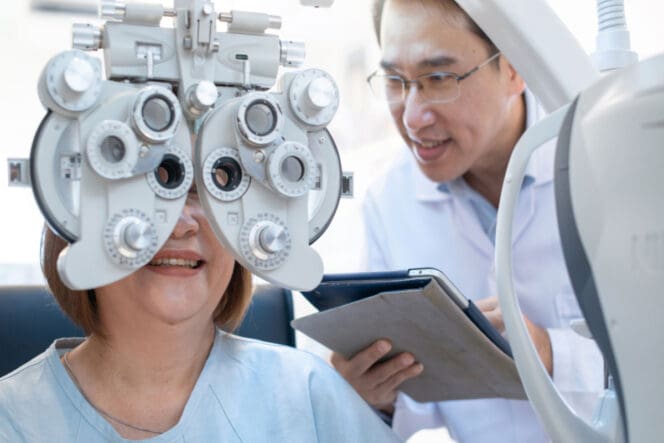How an Eye Doctor Can Transform Your Vision Health in Chino
Understanding the Comprehensive Role of an Optometrist in Modern Eye Treatment
In the advancing landscape of healthcare, the scope of an optometrist's function has dramatically broadened, extending well beyond the confines of conventional vision improvement. With advancements in technology and an enhancing emphasis on preventive care, optometrists are important in identifying and handling chronic eye conditions, while likewise engaging in early condition discovery. Their proficiency in advanced diagnostic strategies such as optical comprehensibility tomography is invaluable. Exactly how do these responsibilities intersect with their role in promoting overall eye health, and what does this mean for client outcomes in a joint health care setting?
Expanded Extent of Practice
In recent years, the duty of eye doctors has progressed significantly, with many professionals now welcoming an increased extent of technique that prolongs past standard eye assessments. Their obligations now encompass a wide range of solutions, consisting of recommending medications for ocular problems, taking care of chronic eye diseases, and performing small medical procedures.
Even more, optometrists are currently a lot more associated with collaborative treatment, functioning carefully with ophthalmologists, medical care physicians, and various other medical care experts to guarantee holistic patient treatment. This interprofessional partnership is important in managing intricate situations that require a multidisciplinary strategy. Furthermore, eye doctors are playing an essential role in public wellness efforts, such as vision testings and eye health and wellness education, focused on improving area health end results.
The broadened extent of method for eye doctors not only boosts their ability to give extensive treatment however additionally deals with the expanding demand for easily accessible and efficient eye care solutions, adding to general medical care improvements.
Very Early Disease Detection
Very early discovery of eye diseases is significantly becoming a centerpiece in the increased role of optometrists. As main eye treatment suppliers, eye doctors are uniquely positioned to determine early indicators of ocular problems such as glaucoma, macular degeneration, diabetic person retinopathy, and cataracts. This pivotal duty is crucial, as early medical diagnosis can significantly improve the administration and diagnosis of these problems, possibly preventing vision loss and improving individual results.
Eye doctors use comprehensive eye evaluations to find refined adjustments in vision and eye wellness. These exams often include assessments of visual acuity, intraocular stress, and retinal wellness. The capacity to identify very early indications of systemic health and wellness problems, such as high blood pressure and diabetic issues, with ocular signs further underscores the importance of regular eye exams. Early treatment is not just useful in protecting vision but also in reducing healthcare costs connected with innovative illness treatments.
Moreover, eye doctors play a crucial duty in individual education, stressing the significance of routine eye assessments as part of total health care. By promoting an aggressive technique to eye care, eye doctors add substantially to public health, making certain diseases are captured and managed properly before they can advance.
Advanced Diagnostic Techniques
Advanced analysis techniques have changed the technique of optometry, allowing specialists to spot and check eye diseases with unmatched precision. These developments have actually changed the optometric landscape, enabling extra sophisticated evaluation and treatment strategies. Technologies such as optical coherence tomography (OCT) supply high-resolution, cross-sectional photos of the retina, helping with very early discovery of problems like glaucoma and macular degeneration. This non-invasive technique has come to be indispensable in modern-day optometry, supplying detailed insights into retinal layers.
One more vital improvement is electronic retinal imaging, which catches detailed views of the retina utilizing high-definition video cameras. This technology is essential in identifying changes in retinal structure over time, thereby assisting in the monitoring of problems like diabetic retinopathy. Visual field screening, boosted by computer-aided systems, permits exact mapping of an individual's field of vision, vital in diagnosing and tracking glaucoma development.
Corneal topography, an additional remarkable diagnostic tool, generates topographic maps of the cornea's surface area. This is particularly advantageous in suitable get in touch with lenses and preparing refractive surgery. These innovative analysis techniques jointly allow optometrists to give positive, targeted care, making sure far better individual outcomes and enhancing their critical role in eye wellness management.
Taking Care Of Chronic Eye Problems
Handling chronic eye problems is a keystone of optometric treatment that requires an extensive understanding of various eye diseases and their lasting implications. Eye doctors play a critical duty in diagnosing, tracking, and handling conditions such as glaucoma, diabetic person retinopathy, and age-related macular degeneration. These conditions, if left unattended, can result in substantial visual disability or loss of sight, highlighting the crucial importance of continuous treatment and management.
Optometrists utilize a variety of diagnostic tools, consisting of optical comprehensibility tomography (OCT), aesthetic field testing, and fundus digital photography, to analyze the progression of these chronic problems. By very closely keeping track of modifications in eye wellness, eye doctors can adjust treatment plans to alleviate condition development. This might involve prescribing medicines, suggesting way of life alterations, or collaborating with eye doctors for medical treatments when necessary.

Role in Preventive Care
Precautionary treatment is here an essential facet of optometry that focuses on maintaining eye wellness and protecting against the onset of ocular illness. Optometrists play an important role in early discovery and avoidance, using normal eye assessments to determine risk aspects and refined adjustments in eye websites health. Eye Doctor Optometrist. These evaluations are not merely concerning vision modification but encompass an extensive assessment of eye features and frameworks, allowing the recognition of problems such as glaucoma, cataracts, and macular degeneration at a beginning
Along with diagnostics, eye doctors inform individuals on lifestyle choices that promote eye wellness, such as appropriate nutrition, UV defense, and the relevance of regular eye examinations. They suggest on the correct use of electronic tools to avoid electronic eye strain, an expanding worry in the digital age. Eye doctors also give advice on safety eyewear for entertainment and job-related tasks, mitigating the danger of injury.
Preventive eye treatment encompasses systemic health and wellness problems that show up in the eyes, such as diabetes and hypertension. By collaborating with various other healthcare experts, optometrists add to all natural person care, stressing the interconnectedness of eye and systemic health. This aggressive technique is vital in securing visual acuity and total wellness.
Conclusion
Optometrists currently occupy a critical role in modern eye care, characterized by an increased scope that consists of identifying and managing persistent eye problems, recommending drugs, and carrying out small operations (Opticore Optometry). Their know-how in early condition discovery is enhanced by sophisticated analysis techniques such as optical coherence tomography and electronic retinal imaging. By highlighting preventative treatment and person education and learning, this hyperlink optometrists contribute considerably to overall eye health and wellness, collaborating with various other health care specialists to make certain thorough and efficient patient outcomes

In addition to diagnostics, eye doctors inform patients on way of life choices that promote eye wellness, such as correct nutrition, UV defense, and the importance of regular eye examinations.Preventative eye treatment prolongs to systemic health and wellness concerns that show up in the eyes, such as diabetes and hypertension.Optometrists currently occupy an essential role in contemporary eye care, characterized by an increased extent that includes detecting and handling persistent eye conditions, suggesting drugs, and carrying out minor surgical procedures.